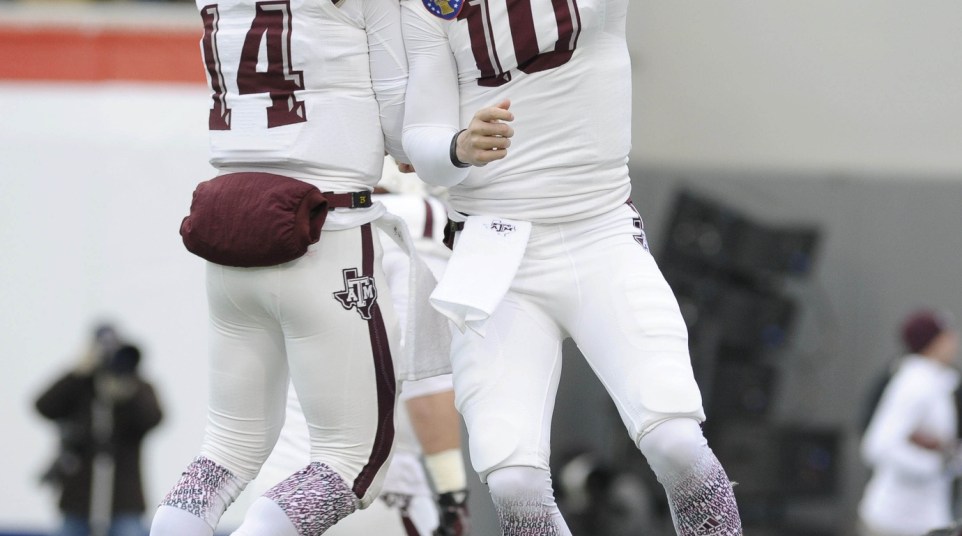Post-spring strengths and weaknesses: Texas A&M
This season is shaping up to be the most pivotal of Kevin Sumlin’s career at Texas A&M.
Last year’s 8-5 record was somewhat expected, as the Aggies were replacing a lot of NFL-level talent with young, inexperienced players. Those players now have a year of experience under their belts, and its expected to show.
On top of that, Mark Snyder took the fall for Texas A&M’s defensive failings, with former LSU defensive coordinator Joh Chavis coming in to take over a unit that finished last in the SEC in total defense the last two years.
The Aggies should be an improved team all-around in 2015. Where are their strengths heading into fall, and where are the team’s weak links?
Strengths
- Rushing the passer — The Aggies brought in Chavis to transform the defense from Swiss cheese to something closer to the Steel Curtain. While it may take a few years for Chavis to get A&M close to being one of the best defenses in the nation, he has a strong foundation to work with along the defensive line. Myles Garrett, Qualen Cunningham and Daeshon Hall form an excellent trio of pass rushers that fit Chavis’ mold of long, athletic players at the defensive end spot. As the Chief simplifies the defense, the pass rush should improve from last year and help start a defensive turnaround.
- Wide receiver depth — Even if Speedy Noil continues to have off-field issues, the Aggies have more than enough ammunition out wide to make up for him. Josh Reynolds emerged as one of the top receiving threats in the conference last fall, with Noil a dangerous player alongside him. The Aggies also have rising redshirt sophomore Ricky Seals-Jones, a physically dominant player, and early enrollee Christian Kirk, who was impressive in spring practice. Add in rising juniors Edward Pope and Boone Niederhofer, who had 30 and 29 catches last year, respectively, and the Aggies have veterans and talent up and down the depth chart.
- Quarterback — How quickly things can change. A week ago, Kyle Allen was the only scholarship quarterback on the Aggies roster. Then, Kyler Murray announced that he is forgoing the Major League Baseball draft, where he could have been a first-round pick, which was followed by top junior college quarterback Jake Hubernak committing to the Aggies. All of a sudden, Texas A&M’s quarterback situation went from a major concern to an area where the coaches can feel more than comfortable, with two capable arms to step up and push Allen.
Weaknesses
- Secondary play — Of all the areas where Texas A&M was terrible on defense last year (basically, all over the place), the secondary may have been the weakest spot, and Texas A&M loses three starters from that group. While cornerback Victor Davis had a good spring, safety Armani Watts is improving and junior college transfer Justin Evans was impressive at safety, there are still more questions than answers in the defensive backfield.
- Running the ball — Sumlin brought in Dave Christensen from Utah to coach the offensive line and coordinate the running game, and the Aggies will need it to be a reliable option this year. Too often last year, when Texas A&M got away from the run, the passing game faltered as a result. Tra Carson can be a battering ram, but Brandon Williams will apparently be a two-way player this year and contribute at cornerback. The Aggies have some talent, but lack depth at the position.
- Linebacker depth — Speaking of depth issues, Chavis could have a problem at linebacker in his first year. Otaro Alaka and Shaan Washington emerged as solid players last year, and A.J. Hilliard returns from injury to possibly reclaim a starting spot. However, three members of the group graduated from last year and Jordan Mastrogiovanni left the team. After the aforementioned three returnees, Chavis will have to rely on a group of inexperienced players, including newcomers Claude George and Richard Moore, both early enrollees.

